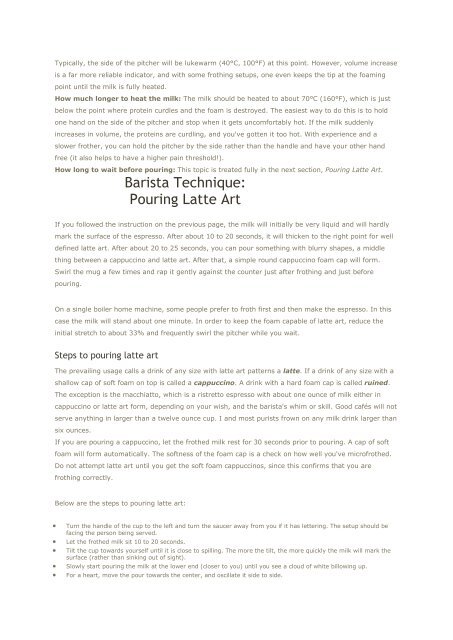The Home Barista's Guide to Espresso - Coffee Prince in Surat
The Home Barista's Guide to Espresso - Coffee Prince in Surat
The Home Barista's Guide to Espresso - Coffee Prince in Surat
You also want an ePaper? Increase the reach of your titles
YUMPU automatically turns print PDFs into web optimized ePapers that Google loves.
Typically, the side of the pitcher will be lukewarm (40°C, 100°F) at this po<strong>in</strong>t. However, volume <strong>in</strong>creaseis a far more reliable <strong>in</strong>dica<strong>to</strong>r, and with some froth<strong>in</strong>g setups, one even keeps the tip at the foam<strong>in</strong>gpo<strong>in</strong>t until the milk is fully heated.How much longer <strong>to</strong> heat the milk: <strong>The</strong> milk should be heated <strong>to</strong> about 70°C (160°F), which is justbelow the po<strong>in</strong>t where prote<strong>in</strong> curdles and the foam is destroyed. <strong>The</strong> easiest way <strong>to</strong> do this is <strong>to</strong> holdone hand on the side of the pitcher and s<strong>to</strong>p when it gets uncomfortably hot. If the milk suddenly<strong>in</strong>creases <strong>in</strong> volume, the prote<strong>in</strong>s are curdl<strong>in</strong>g, and you've gotten it <strong>to</strong>o hot. With experience and aslower frother, you can hold the pitcher by the side rather than the handle and have your other handfree (it also helps <strong>to</strong> have a higher pa<strong>in</strong> threshold!).How long <strong>to</strong> wait before pour<strong>in</strong>g: This <strong>to</strong>pic is treated fully <strong>in</strong> the next section, Pour<strong>in</strong>g Latte Art.Barista Technique:Pour<strong>in</strong>g Latte ArtIf you followed the <strong>in</strong>struction on the previous page, the milk will <strong>in</strong>itially be very liquid and will hardlymark the surface of the espresso. After about 10 <strong>to</strong> 20 seconds, it will thicken <strong>to</strong> the right po<strong>in</strong>t for welldef<strong>in</strong>ed latte art. After about 20 <strong>to</strong> 25 seconds, you can pour someth<strong>in</strong>g with blurry shapes, a middleth<strong>in</strong>g between a cappucc<strong>in</strong>o and latte art. After that, a simple round cappucc<strong>in</strong>o foam cap will form.Swirl the mug a few times and rap it gently aga<strong>in</strong>st the counter just after froth<strong>in</strong>g and just beforepour<strong>in</strong>g.On a s<strong>in</strong>gle boiler home mach<strong>in</strong>e, some people prefer <strong>to</strong> froth first and then make the espresso. In thiscase the milk will stand about one m<strong>in</strong>ute. In order <strong>to</strong> keep the foam capable of latte art, reduce the<strong>in</strong>itial stretch <strong>to</strong> about 33% and frequently swirl the pitcher while you wait.Steps <strong>to</strong> pour<strong>in</strong>g latte art<strong>The</strong> prevail<strong>in</strong>g usage calls a dr<strong>in</strong>k of any size with latte art patterns a latte. If a dr<strong>in</strong>k of any size with ashallow cap of soft foam on <strong>to</strong>p is called a cappucc<strong>in</strong>o. A dr<strong>in</strong>k with a hard foam cap is called ru<strong>in</strong>ed.<strong>The</strong> exception is the macchiat<strong>to</strong>, which is a ristret<strong>to</strong> espresso with about one ounce of milk either <strong>in</strong>cappucc<strong>in</strong>o or latte art form, depend<strong>in</strong>g on your wish, and the barista's whim or skill. Good cafés will notserve anyth<strong>in</strong>g <strong>in</strong> larger than a twelve ounce cup. I and most purists frown on any milk dr<strong>in</strong>k larger thansix ounces.If you are pour<strong>in</strong>g a cappucc<strong>in</strong>o, let the frothed milk rest for 30 seconds prior <strong>to</strong> pour<strong>in</strong>g. A cap of softfoam will form au<strong>to</strong>matically. <strong>The</strong> softness of the foam cap is a check on how well you've microfrothed.Do not attempt latte art until you get the soft foam cappucc<strong>in</strong>os, s<strong>in</strong>ce this confirms that you arefroth<strong>in</strong>g correctly.Below are the steps <strong>to</strong> pour<strong>in</strong>g latte art:Turn the handle of the cup <strong>to</strong> the left and turn the saucer away from you if it has letter<strong>in</strong>g. <strong>The</strong> setup should befac<strong>in</strong>g the person be<strong>in</strong>g served.Let the frothed milk sit 10 <strong>to</strong> 20 seconds.Tilt the cup <strong>to</strong>wards yourself until it is close <strong>to</strong> spill<strong>in</strong>g. <strong>The</strong> more the tilt, the more quickly the milk will mark thesurface (rather than s<strong>in</strong>k<strong>in</strong>g out of sight).Slowly start pour<strong>in</strong>g the milk at the lower end (closer <strong>to</strong> you) until you see a cloud of white billow<strong>in</strong>g up.For a heart, move the pour <strong>to</strong>wards the center, and oscillate it side <strong>to</strong> side.


